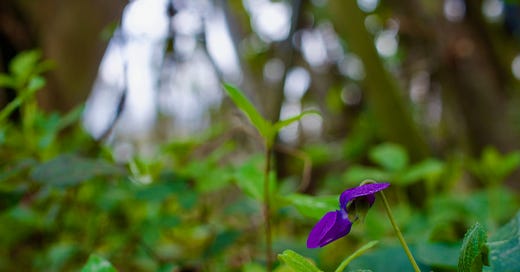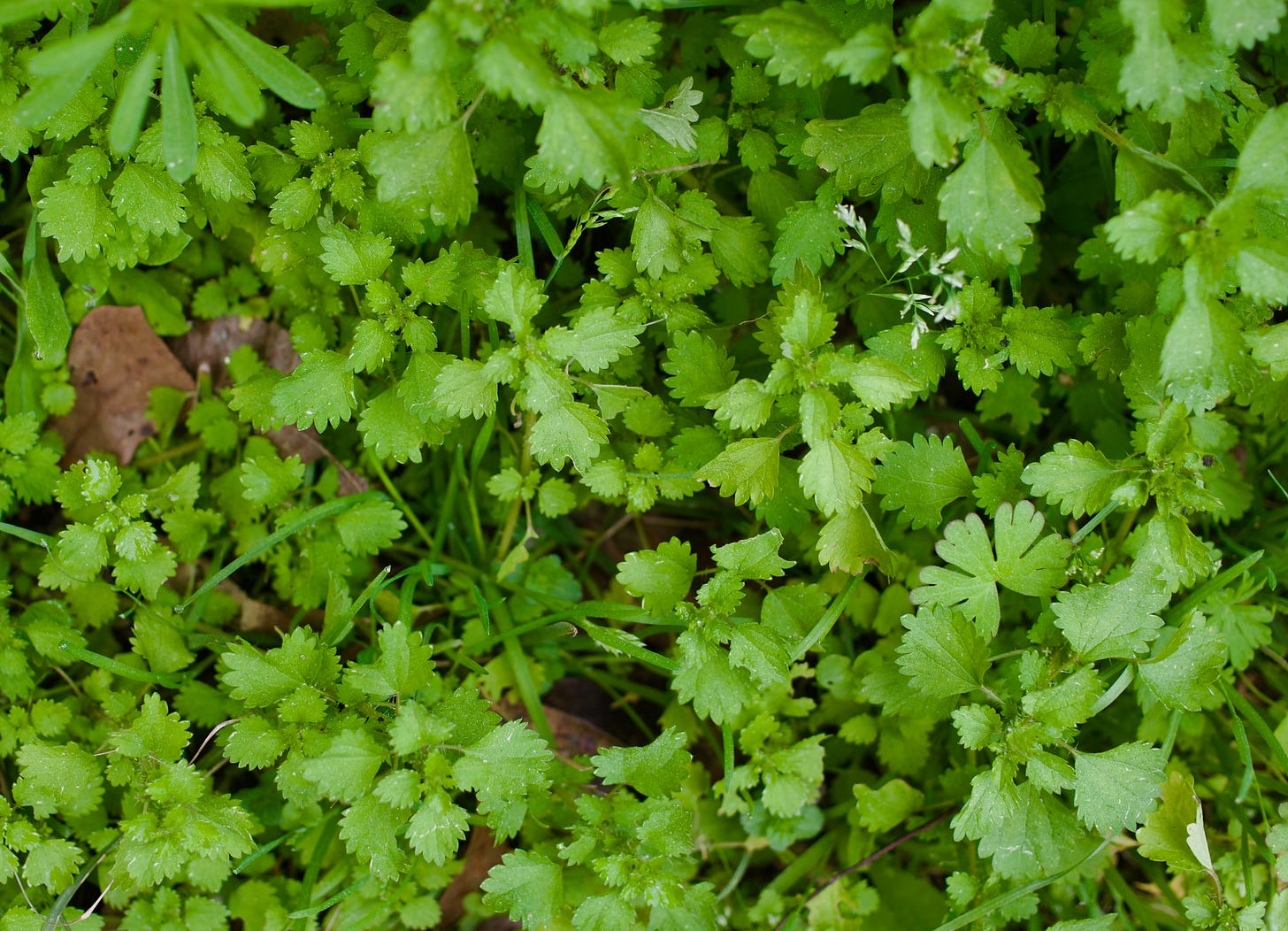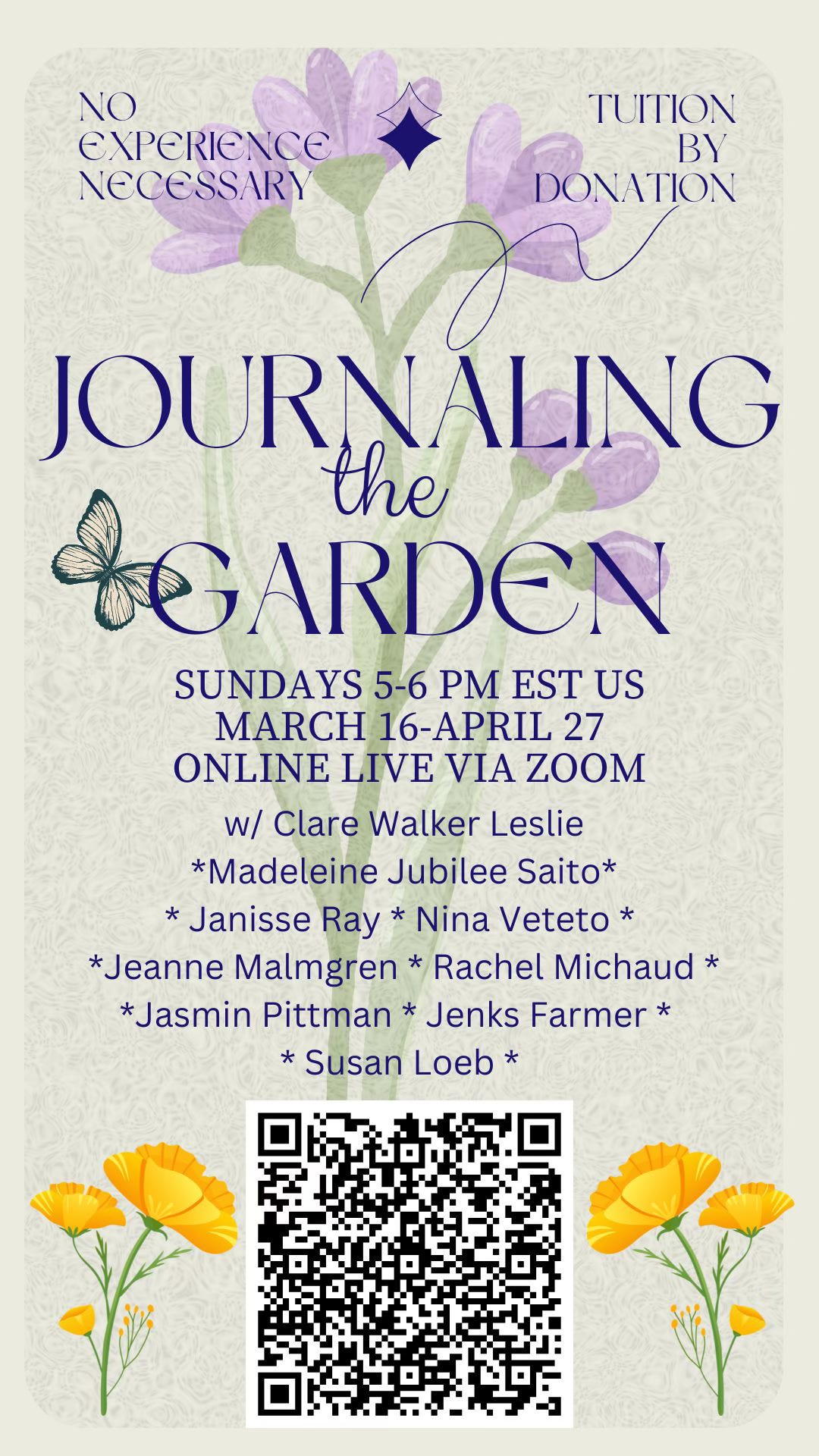Forage a Spring Soup
And you've reached the final day to sign up for the garden journaling class.
WHEN MY FRIEND TRUDY was a girl in Germany, her family had a tradition every spring of preparing a spring tonic of foraged weeds.
“We would spread out around the newly green yard or way out in the meadows,” Trudy wrote in a small pamphlet she indie-published called Eat Your Weeds, “and gather a selection of potherbs under my father’s supervision.”
dandelion (leaves, flower buds, roots)
yarrow (leaves)
sorrel
stinging nettle (leaves)
lamb’s quarter
violet (leaves and flowers)
chickweed
amaranth
milkweed (young shoots)
red clover (leaves)
burdock & curly dock (leaves and roots)
plantain (new leaves)
wild garlic or wild leek
“Mother would fuss if roots with dirt were sneaked into the basket,” Trudy wrote. “At home, it was Mother’s task to clean and pick over the herbs.” Then Frau Crites would begin the soup.
I found Trudy’s booklet Eat Your Weeds this week when I went upstairs to sleep in the guest bedroom. I needed to catch up from my single-mom time in Wisconsin, and it was Raven’s turn to be on duty with the baby. Trudy’s booklet—30 pages—her paintings of weeds with a small description of each—was bedside, stacked atop books about Tasha Tudor’s Vermont garden.
I met Trudy in Vermont soon after I moved to Brattleboro almost twenty years ago. I lived there five years. Raven and I went so that my son, Silas, could have all his parents in one place for high school.
March is Women’s History Month, and I’ve been thinking about women who became my mentors, and I had not thought of Trudy until I came across Eat Your Weeds.
Born Gertrude Elisabeth Bremer, Trudy was a dark-haired child in Germany as her country began to slip into fascism. All around family, friends, and neighbors were being detained, arrested, sent to concentration and work camps, and ultimately murdered. By the time Trudy was 12, things were bad. Trudy’s family desperately tried to find a place to go. Finally Turkey opened its doors.
On a slip of paper taped into the back of Eat Your Weeds, Trudy added her biography. All she said about childhood was that she was “born in Germany and grew up in Turkey.”
In the end, Trudy lost everything she knew. She lost many people she knew. She started life again in Turkey, and when she became of college age, she somehow arrived to Berea College in the United States. She married a professor and had four daughters. Later they divorced. Newly single, with her children grown, Trudy joined the Peace Corps and taught nursing skills in Gambia, West Africa. She was a nurse and a lay minister, with a degree from Yale Divinity School.
When I met Trudy she lived alone in a Tudor-style home on a cliff overlooking the town of Brattleboro. Her house was filled with the artifacts of a well-lived life and also with paintings—she painted, both in plein air and at home. But more than anything Trudy loved plants.
I learned from her to clean dandelion roots in the fall, tuck them into a plastic bag, and refrigerate them in the crisper. All winter the roots release small leaves for harvesting.
I learned how to grow garden in the North. I learned to grow parsnips and gooseberries.
Trudy was the first person with whom I foraged mushrooms; she had learned to do so as a child in Germany. Together we walked the woods of southern Vermont.
Along the Connecticut River she pointed out wild lettuce, poor woman’s opium (Lactuca virosa). It is known as a soporific or sedative, and she showed me how to make homemade sleeping pills. Bring a metal tin of breath mints with you into the woods. Strip a wild lettuce leaf from its stem. A thick white latex—lactucarium—will ooze from the plant. Dab that resin, as much as possible, onto a breath mint and let it soak in. When you get home, you’ll need to re-dry the mints, then return them to the tin. Some medicines in nature are immediately and deeply effective. These sleeping pills, I’m sorry to report, never worked well for me. But I loved the idea.
It was in Trudy’s home that I first tasted spring tonic soup.
This week I would like to celebrate spring with Trudy’s recipe for spring tonic.
I would like to celebrate the power, strength, and genius of women during Women’s History Month by honoring my mentor, the plantswoman Trudy.
I would like to remind us of what happens when a country slips into Nazism (authoritarianism, racism, antisemitism, militaristic expansionism, fascism).
Recipe for Soup of Spring Weeds
Go out foraging for tender green edible potherbs. If you don’t know your weeds, take someone with you who does. For some you will need to gather the roots. Don’t gather all of a patch of a certain plant—leave some to grow and reproduce. And avoid harvesting weeds that grow next to busy highways, industrial areas, or dog-walking parks.
Bring them home and wash well to clean all the dirt off.
Saute an onion in butter.
Add the clean herbs plus water or broth.
Cook into a dark, green soup. It may be blended.
No Photo
I don’t have a photo of Trudy that is handy. I know we have some photos, but where? When I did an Internet search, I found Trudy’s obituary.
You Have Reached the Final Day to Sign up for Journaling the Garden
This is a nature journaling workshop designed for you to process, document, and celebrate life, gardens, spring, and the natural world around you.
School will be
6 Sundays in a row between March and April
hour-long sessions
each Sunday afternoon
5-6 pm Eastern US/Canada Time
starting March 16, 2025
ending April 27, 2025
fabulous writers, artists, & gardeners leading the sessions
with no session on Easter Sunday, April 20.
Sessions will take place on Sunday, March 16 | March 23 | March 30 | April 6 | April 13 | and April 27.
This is not a single event. This is a workshop with 6 sessions. You only need to sign up once. The Zoom link you will receive is the same for all sessions.
TUITION IS YOUR DECISION
Cost of the course is by donation, which means you get to determine the class's value to you. Pay what you wish. The amount you pay remains private.
SCHEDULE
1 | Mar 16 | Janisse w/ Jeanne Malmgren, Guided Garden Meditation
2 | Mar 23 | Janisse w/ Rachel Michaud, Art Tips for Non-Artists
3 | Mar 30 | Janisse w/ Madeleine Jubilee Saito, Wisdom Quadrants
4 | Apr 6 | Janisse w/ Clare W. Leslie, Learning To See
5 | Apr 13 | Janisse w/ Nina Veteto, Capturing Experience With Color
6 | Apr 27 | Janisse w/ Jasmin Pittman, Ancestral Healing Through Creativity (simple wildflowers with watercolor) and
w/ Rachel Michaud, A Season with Black-eyed Susans: Journaling One Plant's Insect Relationships
MORE SPECIFICALLY...
phase of the moon~clouds~phenology (what's happening where you are)~draw a wildflower~ be astonished~a simple banner~a cool page border~5-steps breathing exercise~ map of your garden~how to increase your creativity~your favorite garden~phenology wheel~signs of spring~enso~3 stages of observation~poem templates~shading~outline drawing~getting insects on paper~your garden observations~adding color~wisdom quadrants~simple wildflower watercolors~the weather~rainfall~fragrances~anyone can draw~what spring means to you~seeds







Hi Janisse. The garden journaling looks amazing. Will sessions be recorded and shared for those who sign up?
We did something similar when I was a child, except it was only one plant. In late February in the Carolina foothills, my father and I would walk over my grandfather's farm hunting the sprig shoots of what we called poke salad. As a grown plant, it has poisonous berries and is really bitter. But my mother would cook this baby shoots and we'd flavor them with vinegar or canned hot pepper liquid. They told me that it was full of vitamin C. You may know that a large percentage of WW II draftees were malnourished and failed the physical for the army. My parents told me that fewer southerners failed because of their diet of bean and corn (complementary proteins) and poke salad to provide Vitamin C after a winter without. I have not idea if this is true, but I believed it!